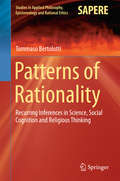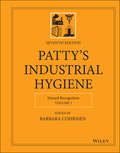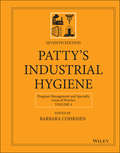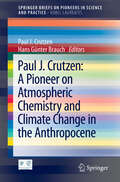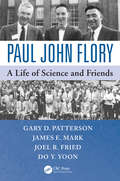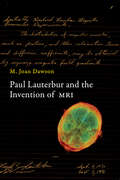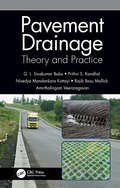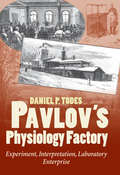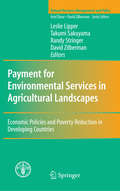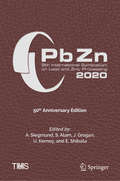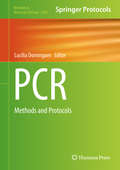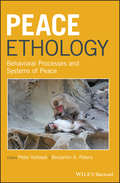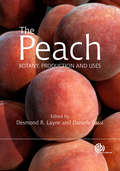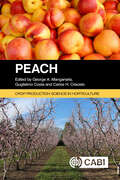- Table View
- List View
Patterns of Rationality
by Tommaso BertolottiThis book proposes an applied epistemological framework for investigating science, social cognition and religious thinking based on inferential patterns that recur in the different domains. It presents human rationality as a tool that allows us to make sense of our (physical or social) surroundings. It shows that the resulting cognitive activity produces a broad spectrum of outputs, such as scientific models and experimentation, gossip and social networks, but also ancient and contemporary deities. The book consists of three parts, the first of which addresses scientific modeling and experimentation, and their application to the analysis of scientific rationality. Thus, this part continues the tradition of eco-cognitive epistemology and abduction studies. The second part deals with the relationship between social cognition and cognitive niche construction, i. e. the evolutionarily relevant externalization of knowledge onto the environment, while the third part focuses on what is commonly defined as "irrational", thus being in a way dialectically opposed to the first part. Here, the author demonstrates that the "irrational" can be analyzed by applying the same epistemological approach used to study scientific rationality and social cognition; also in this case, we see the emergence of patterns of rationality that regulate the relationships between agents and their environment. All in all, the book offers a coherent and unitary account of human rationality, providing a basis for new conceptual connections and theoretical speculations.
Patterns of Synchrony in Complex Networks of Adaptively Coupled Oscillators (Springer Theses)
by Rico BernerThe focus of this thesis is the interplay of synchrony and adaptivity in complex networks. Synchronization is a ubiquitous phenomenon observed in different contexts in physics, chemistry, biology, neuroscience, medicine, socioeconomic systems, and engineering. Most prominently, synchronization takes place in the brain, where it is associated with cognitive capacities like learning and memory, but is also a characteristic of neurological diseases like Parkinson and epilepsy. Adaptivity is common in many networks in nature and technology, where the connectivity changes in time, i.e., the strength of the coupling is continuously adjusted depending upon the dynamic state of the system, for instance synaptic neuronal plasticity in the brain. This research contributes to a fundamental understanding of various synchronization patterns, including hierarchical multifrequency clusters, chimeras and other partial synchronization states. After a concise survey of the fundamentals of adaptive and complex dynamical networks and synaptic plasticity, in the first part of the thesis the existence and stability of cluster synchronization in globally coupled adaptive networks is discussed for simple paradigmatic phase oscillators as well as for a more realistic neuronal oscillator model with spike-timing dependent plasticity. In the second part of the thesis the interplay of adaptivity and connectivity is investigated for more complex network structures like nonlocally coupled rings, random networks, and multilayer systems. Besides presenting a plethora of novel, sometimes intriguing patterns of synchrony, the thesis makes a number of pioneering methodological advances, where rigorous mathematical proofs are given in the Appendices. These results are of interest not only from a fundamental point of view, but also with respect to challenging applications in neuroscience and technological systems.
Patty's Industrial Hygiene, Evaluation and Control: 4 Volume Set
by Barbara CohrssenSince the first edition in 1948, Patty’s Industrial Hygiene and Toxicology has become a flagship publication for Wiley. During its nearly seven decades in print, it has become a standard reference for the fields of occupational health and toxicology. The volumes on industrial hygiene are cornerstone reference works for not only industrial hygienists but also chemists, engineers, toxicologists, lawyers, and occupational safety personnel. Volume 3 covers Recognition and Evaluation of Physical Agents and Biohazards. All of the chapters have been updated and a new chapter on Robotics has been added. These subjects are increasing in importance to industrial hygienists.
Patty's Industrial Hygiene, Hazard Recognition: 4 Volume Set
by Barbara CohrssenSince the first edition in 1948, Patty’s Industrial Hygiene and Toxicology has become a flagship publication for Wiley. During its nearly seven decades in print, it has become a standard reference for the fields of occupational health and toxicology. The volumes on industrial hygiene are cornerstone reference works for not only industrial hygienists but also chemists, engineers, toxicologists, lawyers, and occupational safety personnel. Volume 1 covers Introduction of Industrial Hygiene and Recognition of Chemical Agents. In addition to revised and updated chapters, a number of new chapters reflect current technology and concerns. The chapters include Ethics in Industrial Hygiene, Prevention through Design, Risk Communication, Managing Workplace Demographics, and Mastering Digital Media for Workers, Employers and Community Practice.
Patty's Industrial Hygiene, Physical and Biological Agents: 4 Volume Set
by Barbara CohrssenSince the first edition in 1948, Patty’s Industrial Hygiene and Toxicology has become a flagship publication for Wiley. During its nearly seven decades in print, it has become a standard reference for the fields of occupational health and toxicology. The volumes on industrial hygiene are cornerstone reference works for not only industrial hygienists but also chemists, engineers, toxicologists, lawyers, and occupational safety personnel. Volume 3 covers Recognition and Evaluation of Physical Agents and Biohazards. All of the chapters have been updated and a new chapter on Robotics has been added. These subjects are increasing in importance to industrial hygienists.
Patty's Industrial Hygiene, Program Management and Specialty Areas of Practice
by Barbara CohrssenSince the first edition in 1948, Patty’s Industrial Hygiene and Toxicology has become a flagship publication for Wiley. During its nearly seven decades in print, it has become a standard reference for the fields of occupational health and toxicology. The volumes on industrial hygiene are cornerstone reference works for not only industrial hygienists but also chemists, engineers, toxicologists, lawyers, and occupational safety personnel. Volume 4 covers environmental and health and safety program management, with a number of new chapters on sustainability, construction health and safety, health and safety of new energies and working with cannabis.
Paul J. Crutzen: A Pioneer on Atmospheric Chemistry and Climate Change in the Anthropocene
by Hans Günter Brauch Paul J. CrutzenThis book contains texts by the Nobel laureate Paul J. Crutzen who is best known for his research on ozone depletion. It comprises Crutzen's autobiography, several pictures documenting important stages of his life, and his most important scientific publications. The Dutch atmospheric chemist is one of the world's most cited scientists in geosciences. His political engagement makes him a tireless ambassador for environmental issues such as climate change. He popularized the term 'Anthropocene' for the current geological era acknowledging the enduring influence of humankind on planet Earth. This concept conceives humans to be a geologic factor, influencing the evolution of our globe and the living beings populating it. The selection of texts is representing Paul Crutzen´s scientific oeuvre as his research interests span from ozone depletion to the climatic impacts of biomass burning, the consequences of a worldwide atomic war - the Nuclear Winter - to geoengineering and the Anthropocene.
Paul J. Crutzen: A Pioneer on Atmospheric Chemistry and Climate Change in the Anthropocene (SpringerBriefs on Pioneers in Science and Practice #50)
by Hans Günter Brauch Paul J. CrutzenThis book contains texts by the Nobel laureate Paul J. Crutzen who is best known for his research on ozone depletion. It comprises Crutzen’s autobiography, several pictures documenting important stages of his life, and his most important scientific publications. The Dutch atmospheric chemist is one of the world’s most cited scientists in geosciences. His political engagement makes him a tireless ambassador for environmental issues such as climate change. He popularized the term ‘Anthropocene’ for the current geological era acknowledging the enduring influence of humankind on planet Earth. This concept conceives humans to be a geologic factor, influencing the evolution of our globe and the living beings populating it. The selection of texts is representing Paul Crutzen´s scientific oeuvre as his research interests span from ozone depletion to the climatic impacts of biomass burning, the consequences of a worldwide atomic war – the Nuclear Winter - to geoengineering and the Anthropocene.
Paul John Flory: A Life of Science and Friends
by Gary D. Patterson James E. Mark Joel Fried Do YoonPaul John Flory: A Life of Science and Friends is the first full-length treatment of the life and work of Paul John Flory, recipient of the Nobel Prize in chemistry in 1974. It presents a chronological progression of his scientific, professional, and personal achievements as recounted and written by his former students and colleagues.This book cove
Paul Lauterbur and the Invention of MRI
by M. Joan DawsonThe story behind the invention of the most important medical diagnostic tool since the X-ray.On September 2, 1971, the chemist Paul Lauterbur had an idea that would change the practice of medical research. Considering recent research findings about the use of nuclear magnetic resonance (NMR) signals to detect tumors in tissue samples, Lauterbur realized that the information from NMR signals could be recovered in the form of images—and thus obtained noninvasively from a living subject. It was an unexpected epiphany: he was eating a hamburger at the time. Lauterbur rushed out to buy a notebook in which to work out his idea; he completed his notes a few days later. He had discovered the basic method used in all MRI scanners around the world, and for this discovery he would share the Nobel Prize for Physiology or Medicine in 2003. This book, by Lauterbur's wife and scientific partner, M. Joan Dawson, is the story of Paul Lauterbur's discovery and the subsequent development of the most important medical diagnostic tool since the X-ray.With MRI, Lauterbur had discovered an entirely new principle of imaging. Dawson explains the science behind the discovery and describes Lauterbur's development of the idea, his steadfastness in the face of widespread skepticism and criticism, and related work by other scientists including Peter Mansfield (Lauterbur's Nobel co-recipient), and Raymond Damadian (who famously feuded with Lauterbur over credit for the ideas behind MRI). She offers not only the story of one man's passion for his work but also a case study of how science is actually done: a flash of insight followed by years of painstaking work.
Paul Rogers: With a Foreword by Jenny Pearce (Pioneers in Arts, Humanities, Science, Engineering, Practice #21)
by Paul RogersThis book brings together a collection of writings over the past half century from Professor Paul Rogers. As a leading peace researcher he has gained an international reputation for the critical, independent and rigorous analysis of international security and the underlying causes of global conflict. His work on the responses to 9/11 and the continuing failure of the war on terror, in particular, has shown prescience that has attracted widespread attention. Moreover, he has coupled his academic analysis with a determination to communicate widely beyond the university environment. With many thousands of radio and television interviews, hundreds of public lectures and a world-wide following for his web publishing, this extramural engagement consistently seeks to raise the level of public debate on international security issues.- Provides a radically different perspective on global security, based on 50 years of analysis- Uniquely integrates economic, environmental and security analysis into a single overview- Cogently demonstrates the urgent need to rethink our entire approach to global security
Paulin Hountondji and the Science Question in Africa (Political Epistemology)
by Zeyad el NabolsyThis book offers a systematic reconstruction of Paulin Hountondji&’s contributions to the debate about the place of modern science on the African continent. The book shows that Hountondji develops an account of modern science that is sociologically sensitive to the entanglement between modern science and colonialism on the African continent without falling into epistemic relativism about the claims of modern science. It is argued that Hountondji&’s views on modern science express a strong historical materialist influence, and that he develops a theory of science that draws both on the Hessen-Grossmann hypothesis and dependency theory. Thus, this book brings together two strands of historical materialist thought about science that have hitherto been isolated from one another. This book is of interest to scholars who specialize in African philosophy, history and philosophy of science, global philosophy, and African studies.
Paulo's Parachute Mission
by Engineering is Elementary TeamPaulo is not happy about his family's move to Alcantara, Brazil to be close to its space launch pad. <P><P>While Paulo's parents, both aerospace engineers, are excited about the design projects in their new jobs, Paulo is worried about leaving his friends behind and meeting new people. The last thing he wants to do is make friends with his new neighbor, Lucas.
Pavement Drainage: Theory and Practice
by G L Babu Prithvi S. Kandhal Nivedya Mandankara Kottayi Rajib Basu Mallick Amirthalingam VeeraragavanSUMMARY This book provides complete coverage of surface and subsurface drainage of all types of pavements for highways, urban roads, parking lots, airports, and container terminals. It provides up-to-date information on the principles and technologies for designing and building drainage systems and examines numerous issues, including maintenance and designing for flood events. Practical considerations and sophisticated analysis, such the use of the finite element method and unsaturated soil mechanics, anisotropy and uncertainties, are presented. This book allows civil engineers to make the best use of their resources to provide cost effective and sustainable pavements. Features Presents a holistic consideration of drainage with respect to pavement performance. Includes numerous practical case studies. Examines flooding and the impacts of climate change. Includes PowerPoint slides which include quizzes, schematics, figures, and tables.
Pavement Materials and Associated Geotechnical Aspects of Civil Infrastructures: Proceedings of the 5th GeoChina International Conference 2018 – Civil Infrastructures Confronting Severe Weathers and Climate Changes: From Failure to Sustainability, held on July 23 to 25, 2018 in HangZhou, China (Sustainable Civil Infrastructures)
by WJvdM Steyn Irina Holleran BooHyun NamThis book contains latest research studies regarding issues related to civil infrastructure such as pavement layers and material properties. It contains research data and conclusions that should lead to more resilient infrastructure design, maintenance and management. Civil engineering researchers and practitioners will gain valuable information from this material. Papers were selected from the 5th GeoChina International Conference on Civil Infrastructures Confronting Severe Weathers and Climate Changes: From Failure to Sustainability, held on July 23-25, 2018 in HangZhou, China.
Pavlov's Physiology Factory: Experiment, Interpretation, Laboratory Enterprise
by Daniel P. TodesRussian physiologist and Nobel Prize winner Ivan Pavlov is most famous for his development of the concept of the conditional reflex and the classic experiment in which he trained a dog to salivate at the sound of a bell. In Pavlov's Physiology Factory: Experiment, Interpretation, Laboratory Enterprise, Daniel P. Todes explores Pavlov's early work in digestive physiology through the structures and practices of his landmark laboratory—the physiology department of the Imperial Institute for Experimental Medicine. In Lectures on the Work of the Main Digestive Glands, for which Pavlov won the Nobel Prize in 1904, the scientist frequently referred to the experiments of his coworkers and stated that his conclusions reflected "the deed of the entire laboratory." This novel claim caused the prize committee some consternation. Was he alone deserving of the prize? Examining the fascinating content of Pavlov's scientific notes and correspondence, unpublished memoirs, and laboratory publications, Pavlov's Physiology Factory explores the importance of Pavlov's directorship of what the author calls a "physiology factory" and illuminates its relationship to Pavlov's Nobel Prize-winning work and the research on conditional reflexes that followed it.Todes looks at Pavlov's performance in his various roles as laboratory manager, experimentalist, entrepreneur, and scientific visionary. He discusses changes wrought by government and commercial interests in science and sheds light on the pathways of scientific development in Russia—making clear Pavlov's personal achievements while also examining his style of laboratory management. Pavlov's Physiology Factory thus addresses issues of importance to historians of science and scientists today: "big" versus "small" science, the dynamics of experiment and interpretation, and the development of research cultures.
Pawpaws: The Complete Growing and Marketing Guide
by Blake Cothron“With this valuable book, you can pawpaw your own food forests, restoring the diversity, abundance, and climate we all need.” —Albert Bates, permaculture instructor, ecovillage designer, author of The Biochar SolutionPawpaws is the first in-depth guide to small-scale commercial cultivation of pawpaws. Also known as Indiana bananas or hipster bananas, this almost forgotten fruit, native to North America, is making a huge comeback with foodies, chefs, craft brewers, and discerning fruit-lovers.Written by, and for, the organic grower, coverage includes:Botany and the cultural history of pawpawsOrchard siting and planningChoosing the best-quality nursery treesDescriptions of over fifty cultivarsPropagation and organic growing tipsPests and disease managementMarketing and selling fresh pawpaws, seeds, and startsProcessing and producing value-added products.Get ahead of the farming curve, diversify your orchard or food forest, and discover the commercial potential of America’s almost forgotten native fruit with this comprehensive manual to small-scale commercial pawpaw production.“Blake Cothron is an authority on pawpaws and provides a clear, detailed guide for commercial success in growing this ‘oddly appealing species’ (his own words). The supply of this exotic, trending, easy-to-grow fruit has not yet met the demand. Blake shares the wealth of his knowledge, including challenges—and when he doesn’t know, he says so (it’s probable that others don’t know either).” —Pam Dawling, author of Sustainable Market Farming“The pawpaw’s revival is long overdue. Blake Cothron’s Pawpaws will help bring about the day when fragrant fruit is no longer a rare treat, but a regular part of our seasonal diet.” —Darrell E. Frey, Three Sisters Farm, author of Bioshelter Market Garden
Payment for Environmental Services in Agricultural Landscapes
by David Zilberman Takumi Sakuyama Leslie Lipper Randy StringerIn recent years, development policy has responded to an increasing concern about natural resource degradation by setting up innovative payment for environmental services (PES) programs in developing countries. PES programs use market and institutional incentives in order to meet both environmental and poverty alleviation objectives. However, their optimal design, implications for the rural poor, and how these initiatives integrate into international treaties on global warming and biodiversity loss are still being discussed. This book addresses these issues by scrutinizing analytical tools, providing policy insights and stimulating debate on linkages between poverty alleviation and environmental protection. In particular, it turns attention towards the role of environmental services in agricultural landscapes as they provide a living for many poor in developing countries. It serves as a valuable reference for academics and students in various disciplines, as well as for policy makers and advisors. This book is a co-publication between Springer and the Food and Agriculture Organization of the United Nations.
PbZn 2020: 9th International Symposium on Lead and Zinc Processing (The Minerals, Metals & Materials Series)
by J. Grogan A. Siegmund S. Alam U. Kerney E. ShibataEstablished in 1970, the PbZn symposium series is considered the leading international technical forum for the lead and zinc processing industries. The PbZn 2020 volume addresses all aspects of current processing technologies for primary and secondary lead and zinc, as well as emerging technologies for both metals.
Pcr: Methods and Protocols (Methods in Molecular Biology #1620)
by Lucília DominguesThis volume details PCR technique with focus on its application specificities to the biotechnology and bioengineering field. Chapters are broken into five sections covering sgeneral PCR protocols, different applied examples to molecular and synthetic biotechnology, food science and technology, environmental microbiology and molecular ecology, and healthcare. Written in the highly successful Methods in Molecular Biology series format, chapters include introductions to their respective topics, lists of the necessary materials and reagents, step-by-step, readily reproducible laboratory protocols, and tips on troubleshooting and avoiding known pitfalls.Authoritative and cutting-edge, PCR: Methods and Protocols hopes to be a valuable and useful resource for wet lab researchers, particularly within the biotechnology and bioengineering field.
Peace Ethology: Behavioral Processes and Systems of Peace
by Peter Verbeek Benjamin A. PetersA scholarly collection of timely essays on the behavioral science of peace With contributions from experts representing a wide variety of scholarly fields (behavioral and social sciences, philosophy, environmental science, anthropology and economics), Peace Ethology offers original essays on the most recent research and findings on the topic of the behavioral science of peace. This much-needed volume includes writings that examine four main areas of study: the proximate causation of peace, the developmental aspects of peace, the function and systems of peace and the evolution of peace. The popular belief persists that, by nature, humans are not pre-disposed to peace. However, archeological and paleontological evidence reveals that the vast majority of our time as a species has been spent in small hunter-gatherer bands that are basically peaceful and egalitarian in nature. The text also reveals that most of the earth’s people are living in more peaceful societies than in centuries past. This hopeful compendium of essays: Contains writings from noted experts from a variety of academic studies Offers a social-psychological perspective on the causation of peaceful behavior Includes information on children’s peacekeeping and peacemaking Presents ideas for overcoming social tension between police and civilians Provides the most recent thinking on the behavioral science of peace Written for students and academics of the behavioral and social sciences, Peace Ethology offers scholarly essays on the development, nature, and current state of peace.
Peach
by Albert Abbott Angelo Ramina Gregory Reighard Andy Nyczepir Dan Horton Desmond Layne Bruce Topp Richard Marini Rene Monet Daniele Bassi Tom Gradziel R. Johnson Hongwen Huang Filiberto Loreti Thomas Tworkoski William Okie Mariano Cambra Luca Corelli-Grappadelli James Adaskaveg Carlos Crisosto Theodore DeJong David RitchieThe Peach provides a comprehensive up to date reference work, summarizing our knowledge of peaches and their production worldwide and includes an extensive colour plates section. Chapters written by international authorities address botany and taxonomy, breeding and genetics of cultivars and rootstocks, propagation, physiology and planting systems, crop and pest management and postharvest physiology. The book also includes a contribution on the history of cultivation and production trends in China with historical references dating back to 1100 B.C for the first time in the English language.
Peach (Crop Production Science in Horticulture)
by Maria Luisa Badenes Gregory Reighard Daniele Bassi James Adaskaveg David Ritchie Daniela Giovannini Nikolaos T Papadopoulos Helga Förster Thomas M Gradziel Gemma Echeverria Gregory A Lang B. Anthony B. Blaauw C. Bonghi A. Botton M. Cirilli Luis Cisneros-Zevallos M. Christofi B. Dichio M. F. Drincovich P. Drogoudi S. Foschi K. Gasic I. Iglesias J. C. Melgar P. Milonas I. S. Minas B. Morandi M. Á. Moreno A. L. Nielsen J. Pieper G. Reig S. Sansavini Guido Schnabel P. Tonutti L. Trainotti A. R Vicente C. XiloyannisPeach is a highly valuable temperate fruit crop with significant consumer demand and nutraceutical benefits. This book provides comprehensive and up-to-date coverage on sustainable production processes for peach and nectarine. The latter is a natural mutation of peach that lacks fuzzy skin. It includes fundamental information to help reduce production risks for growers, improve fruit quality, and increase potential market returns, whilst addressing current emerging issues such as climate change and shifting global and regional production practices. Written by an international team of expert authors and highly illustrated in full colour throughout, Peach presents information in an organized and easy-to-follow manner, with content including: Peach tree architecture. Rootstocks. Cultivars. In-field operations (irrigation, fertilization, thinning, harvest) Fruit quality, composition and nutritional benefits. Peach fruit growth, development and ripening physiology. Postharvest technology, including supply chain management protocols. Preharvest and postharvest diseases. Biology and management of insect pests. The peach canning industry. This is an essential resource for students and researchers in horticulture, as well as professionals in pomology including fruit growers, consultants and extension specialists, and cold storage and transportation managers.

